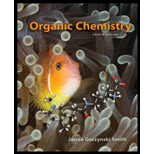
Concept explainers
(a)
Interpretation: The expected molecular ions of the given compounds are to be stated.
Concept introduction: Molecular ion is the radical cation which is formed by ejection of electrons from a molecule when a beam of high-energy electrons are bombarded on it.
(b)
Interpretation: The expected molecular ions of the given compounds are to be stated.
Concept introduction: Molecular ion is the radical cation which is formed by ejection of electrons from a molecule when a beam of high-energy electrons are bombarded on it.
(c)
Interpretation: The expected molecular ions of the given compounds are to be stated.
Concept introduction: Molecular ion is the radical cation which is formed by ejection of electrons from a molecule when a beam of high-energy electrons are bombarded on it.
(d)
Interpretation: The expected molecular ions of the given compounds are to be stated.
Concept introduction: Molecular ion is the radical cation which is formed by ejection of electrons from a molecule when a beam of high-energy electrons is bombarded on it.
Want to see the full answer?
Check out a sample textbook solution
Chapter 13 Solutions
Package: Organic Chemistry With Connect 2-semester Access Card
- What molecular ions would you expect for compounds having the molecular formula C6 H11 Brarrow_forwardDetermine a molecular formula, e.g. CH4, from the line structure below.Specify elements in the following order:, others(in alphabetical order).Example: C4H7CIOSarrow_forwardWrite molecular formulas for the five possible molecular ions of m/z 100 containing only the elements C, H, N, and O.arrow_forward
- The molecular weight of the acetic acid (CH3CO2H) is __________ amu. a 48.12 b 60.06 c 44.00 d 32.88arrow_forwardAn unknown compound has the formula C8H9BrO. Determine the structure of this compound through the data from the figures provided.arrow_forwardWhat is the molecular formula of the CHN-containing compound, M^+=80?arrow_forward
 Organic ChemistryChemistryISBN:9781305580350Author:William H. Brown, Brent L. Iverson, Eric Anslyn, Christopher S. FootePublisher:Cengage Learning
Organic ChemistryChemistryISBN:9781305580350Author:William H. Brown, Brent L. Iverson, Eric Anslyn, Christopher S. FootePublisher:Cengage Learning Chemistry: The Molecular ScienceChemistryISBN:9781285199047Author:John W. Moore, Conrad L. StanitskiPublisher:Cengage Learning
Chemistry: The Molecular ScienceChemistryISBN:9781285199047Author:John W. Moore, Conrad L. StanitskiPublisher:Cengage Learning

